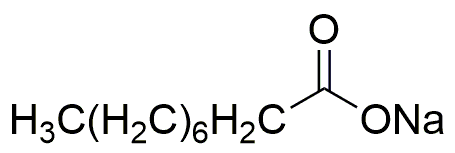Sodium nonanoate is widely utilized in research focused on:
- Food Industry: Used as a food preservative, it helps inhibit the growth of bacteria and fungi, extending the shelf life of products.
- Cosmetics: Acts as an emulsifier and stabilizer in creams and lotions, enhancing texture and consistency while ensuring product stability.
- Pharmaceuticals: Serves as a surfactant in drug formulations, improving the solubility and bioavailability of active ingredients.
- Agriculture: Functions as a biodegradable surfactant in pesticide formulations, improving the spread and adherence of active ingredients on plant surfaces.
- Research Applications: Employed in laboratory settings for various chemical syntheses and as a reagent in organic chemistry, facilitating reactions due to its surfactant properties.
General Information
Properties
Safety and Regulations
Applications
Sodium nonanoate is widely utilized in research focused on:
- Food Industry: Used as a food preservative, it helps inhibit the growth of bacteria and fungi, extending the shelf life of products.
- Cosmetics: Acts as an emulsifier and stabilizer in creams and lotions, enhancing texture and consistency while ensuring product stability.
- Pharmaceuticals: Serves as a surfactant in drug formulations, improving the solubility and bioavailability of active ingredients.
- Agriculture: Functions as a biodegradable surfactant in pesticide formulations, improving the spread and adherence of active ingredients on plant surfaces.
- Research Applications: Employed in laboratory settings for various chemical syntheses and as a reagent in organic chemistry, facilitating reactions due to its surfactant properties.
Documents
Safety Data Sheets (SDS)
The SDS provides comprehensive safety information on handling, storage, and disposal of the product.
Product Specification (PS)
The PS provides a comprehensive breakdown of the product’s properties, including chemical composition, physical state, purity, and storage requirements. It also details acceptable quality ranges and the product's intended applications.
Certificates of Analysis (COA)
Search for Certificates of Analysis (COA) by entering the products Lot Number. Lot and Batch Numbers can be found on a product’s label following the words ‘Lot’ or ‘Batch’.
*Catalog Number
*Lot Number
Certificates Of Origin (COO)
This COO confirms the country where the product was manufactured, and also details the materials and components used in it and whether it is derived from natural, synthetic, or other specific sources. This certificate may be required for customs, trade, and regulatory compliance.
*Catalog Number
*Lot Number
Safety Data Sheets (SDS)
The SDS provides comprehensive safety information on handling, storage, and disposal of the product.
DownloadProduct Specification (PS)
The PS provides a comprehensive breakdown of the product’s properties, including chemical composition, physical state, purity, and storage requirements. It also details acceptable quality ranges and the product's intended applications.
DownloadCertificates of Analysis (COA)
Search for Certificates of Analysis (COA) by entering the products Lot Number. Lot and Batch Numbers can be found on a product’s label following the words ‘Lot’ or ‘Batch’.
*Catalog Number
*Lot Number
Certificates Of Origin (COO)
This COO confirms the country where the product was manufactured, and also details the materials and components used in it and whether it is derived from natural, synthetic, or other specific sources. This certificate may be required for customs, trade, and regulatory compliance.

